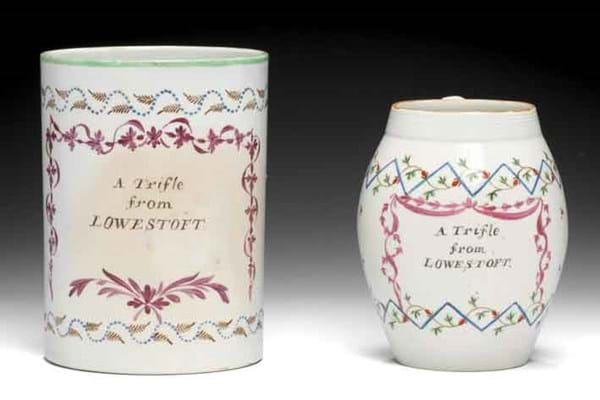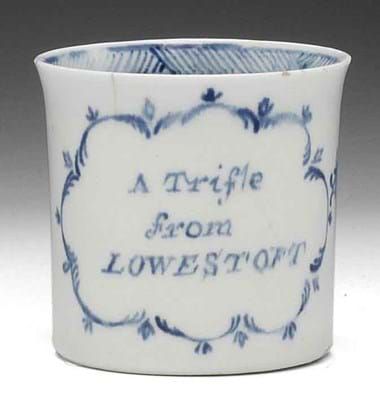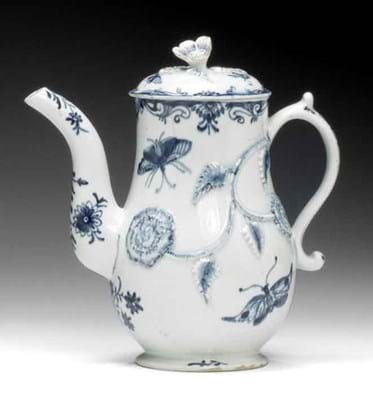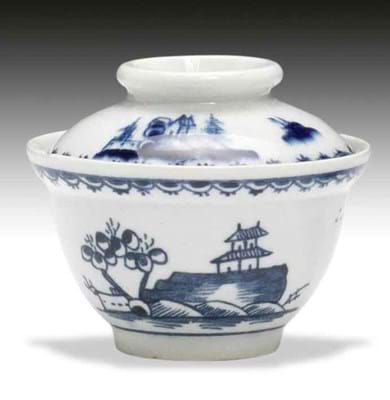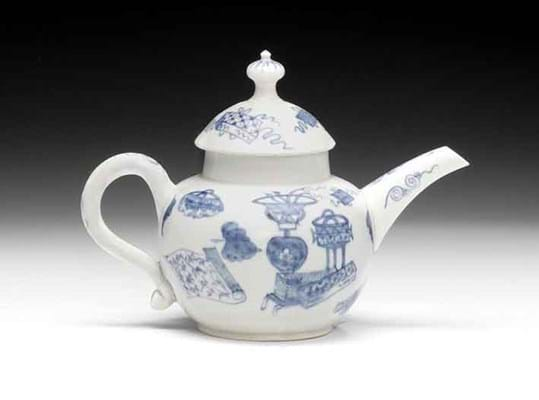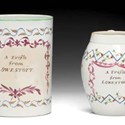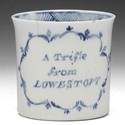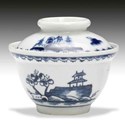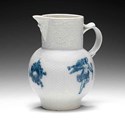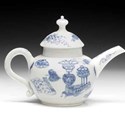Here porcelain from the major 18th century Regency, early 19th century and Welsh factories made up 280 of the 602 lots, getting on for half the content. The remainder was given over the early pottery discussed elsewhere on these pages and a selection of later wares, Royal Worcester and pâte-sur-pâte from the Bernard Bumpus collection.
Alongside the usual selection of early Worcester, Bow and Chelsea, this sale was swelled by a particularly large offering of Lowestoft from two different vendors.
Twenty-seven lots of blue and white came from the Geoffrey Godden's well-known reference collection and followed on from the pieces he sold last year and part of his single-owner auction in June 2010. A further 37 lots of blue and white and polychrome inscribed wares came from the Paul collection, formed by several generations of the same family between the 1930s and '50s.
The two collections therefore complemented each other well, but taken together comprised a very large number of pieces from this factory in one sitting.
Lowestoft is a strong market with a very keen private following, but its output and buying base is not as large as, say, Worcester and the estimates were not there-to-be-sold giveaways. So the burning question was, would the market be able to absorb it?
"We saw no reason to presume that the market could not take it," said Bonhams' Ceramics head John Sandon after the auction. It all went, he said, adding that while it didn't make over estimate this was because they had judged the estimates accurately for a field that is collector dominated.
"We had plenty of material to base prices on." As well as last year's slice of Godden Lowestoft, in 2007 Bonhams sold 52 lots of blue and white Lowestoft in the Sutherland collection. "The market hasn't been swamped even though we've thrown a lot at it," he commented.
Certainly the results bore this out, for nothing failed to sell in the Godden selection and only two lots were left without takers in the Paul ensemble. Many Lowestoft collectors are quite happy to come and bid personally for their prizes (although mindful that many are locally based, Bonhams sensibly took a selection of pieces to East Anglia to preview in their Bury St Edmunds office). As predicted, the majority of the material went to private collectors or to one or two dealers bidding on commission.
Bidding Competition
Every buyer, especially seasoned aficionados, will fight over the rarities to fill gaps in their collection and at Bonhams this was where the most notable results occurred.
A good illustration was provided by four small mugs in the Paul collection dating from 1795, painted with polychrome floral motifs and with a puce cartouche framing the legend A Trifle from Lowestoft.
Heights ranged from around 4-4¾in (10-12cm) and estimates from £1500-2000 up to £6000-8000 based on condition and shape. Prices followed estimates.
The most expensive was for the only barrel-shaped version (all the others were cylindrical) and the only one with no damage. It was published in Godden's Lowestoft Porcelain and like many of the Paul collection's best pieces had featured in the 1957 Lowestoft China Bicentenary Exhibition.
It duly topped that guide to take £11,500, the highest Lowestoft price of the auction.
The cheapest of the quartet was the lowest estimated and had a broken and restored handle and patches of staining. It just tipped over predictions at £2200. The other polychrome versions realised a within-estimate £3200 for a cracked and slightly stained example and a double-estimate £6500 for the smallest and the least damaged of the cylindrical versions with just a fine crack.
Prized Rarities
There was also a smaller 2½in (6cm) high underglaze blue version in the Godden Lowestoft, regarded as very rare because most 'trifle from..' mugs were polychrome, Similarly decorated but with a cross-hatched interior border, and just one fine crack, it doubled its estimate to take £7000.
Other rarities that got the collectors excited included an underglaze blue pear-shaped coffee pot of c.1765 in the Paul collection that was unusual for being applied in relief with trailing flower stems as well as flat-painted motifs all delicately picked out in blue. It came in at £9500, while the Godden property featured a teapot of c.1790-95 decorated with a standard Two Bird pattern in blue and red that unusually was applied to a cylindrical shape, an unrecorded combination that was enough to take it to £5000.
Not everything performed to expectations. A £6000-8000 guide on a 3½in (7cm) diameter Paul collection birth tablet inscribed SS 1789 to one side and painted with pagodas on an island proved too bullish and it got away at £5000. It had credentials of being ex the Crisp collection and the 1957 bicentenary exhibition but had a broken and restuck rim and John Sandon felt the fact that it was inscribed only with initials and the painting was perhaps not the finest, may have held it back.
Caughley and Limehouse
Lowestoft was not the sole purveyor of rarities in this sale. Both the Paul and the Godden properties offered pieces from other English factories as well.
One was a rare, finely moulded and underglaze blue-decorated, 5½in (13cm) high mask jug from Caughley c.1775, whose printed circular mark to the base reading Salopian and Gallimore Turner provides documentary evidence of the early c.1772 partnership of Ambrose Gallimore and Thomas Turner at the Shropshire factory. An ex-Bernard Watney piece before entering the Godden collection, this outstripped a £7000-10,000 guide to take £13,500.
Among the other treasures that Geoffrey Godden was selling was a very rare Limehouse teapot of c.1746-48, one of four that had originally come from Wentworth Woodhouse in Yorkshire, seat of the Earls of Fitzwilliam. They had been sold as one lot by Christie's in 1948, although at that time they were thought to be Lowestoft. David Mannheim, the dealer who bought them at Christie's, sold them on to Godden's father and Geoffrey purchased three of them from Godden senior for £11.
Two of these sold in last year's Godden reference collection auction for £28,000 and £6000 (for an example lacking a lid).
This third example, decorated with an array of oriental-inspired precious objects, realised a lower-estimate £15,000. It was impeccably provenanced and much published, it is true, but as John Sandon explained: "However rare Limehouse is, we have sold a lot of Limehouse". The air tends to be thin at the top for these trophy pieces from factories with relatively small output.
Market freshness is also a factor and in this 18th century section two or three notable failures in the Worcester had come from the collection of David Butti, which was sold in the same rooms as recently as 2006.
The other notably sticky section came with a small, eight-lot group of Chelsea and St James porcelain scent bottles, none of which found a buyer.
The buyer's premium was 20/12%.

